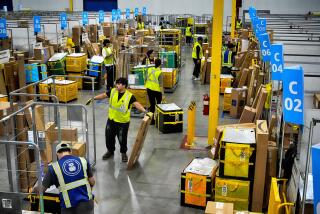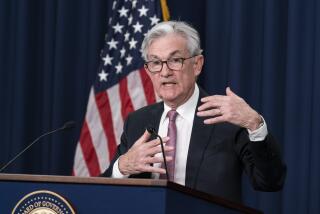Slowdown in Economy Seen as Continuing
WASHINGTON — The U.S. economy slowed this spring to a 1.7% annual growth rate, the Commerce Department reported Thursday, and analysts predicted that economic activity probably will do little more than tread water over the next few months.
The weak second quarter reflects lackluster consumer spending on big-ticket items like automobiles and housing. The slowdown apparently came in response to the Federal Reserve Board’s efforts to combat inflation by pushing up interest rates.
Last quarter’s economic growth was the weakest improvement in America’s gross national product--the broadest measure of the nation’s output of goods and services--since a 0.8% gain in the third quarter of 1986.
During the first quarter, the GNP expanded at a revised 3.7% rate. But most of that gain reflected an apparent recovery in the farm economy from last year’s drought. The non-farm economy grew at a rate of just 1.5% in the first quarter.
Despite the Fed’s efforts, inflation continued to rise in the second quarter. One key inflation indicator climbed at a 5.2% annual rate, compared with 4.6% during the first quarter.
There are hopeful signs, though, that inflation may have peaked. After increasing sharply earlier this year, food costs have declined in recent weeks while energy costs have leveled off.
Indeed, the Fed recently reversed direction, encouraging short-term interest rates to fall since early June because of fears that the current economic slowdown might deteriorate into a nasty recession. The central bank knocked borrowing costs down another notch this week by allowing the federal funds rate on money that banks lend each other to fall to about 9%.
After 6 1/2 years of uninterrupted economic expansion, analysts have been in general agreement that a slowing of the rapid growth of 1987 and 1988 was necessary to prevent inflation from accelerating.
But they remain divided over whether the Fed’s inflation cure will turn out to be worse than the disease.
“The Fed has done as well as anybody could expect,” said John Makin, a top economist at the American Enterprise Institute. “You can’t get inflation down without slowing the economy. The worst that’s likely to happen is a mild recession that will make room for stronger growth next year.”
David Levine, chief economist at Sanford C. Bernstein & Co., a New York investment firm, said that the latest data convinces him there is almost no danger of a recession this year “unless oil prices go to $50 a barrel or an asteroid hits Kansas.”
Levine said he is more worried that inflation will start accelerating later this year than he is about a possible downturn in the economy.
But Irwin Kellner, chief economist at Manufacturers Hanover Bank in New York, fears that the Fed’s credit policy already may have pushed the economy over the edge into a potentially sharp downturn.
The central bank’s recent efforts to ease up may be “too little and too late,” Kellner warned. “The economy is like an airplane. Once it hits the stall speed, it’s not easy to pull it up again.”
The GNP report shows that consumer spending remained weak for the second quarter in a row, rising at a sluggish pace of 1.1%, while spending on expensive, longer-lasting goods like autos and appliances actually fell at a 4% rate.
Housing construction dropped at a rate of 13.6% in the spring, the steepest plunge since the recession-plagued first quarter of 1982.
The nation’s trade imbalance continued to narrow but only by a slight $2.4 billion, compared with a strong $18.8 billion improvement in the first quarter.
With the release of Thursday’s figures, the government also disclosed its annual revision of past GNP gains. The new data shows that the economy grew a robust 4.4% in 1988, an improvement from the earlier estimate of 3.9% growth.
A key sign that the economy remains in good shape was the indication that inventories grew no faster than final sales to buyers during the spring. That suggests business planners are unlikely to face demands to cut back much further on production later this summer.
Last week, the Bush Administration slightly lowered its economic forecast for this year, putting estimated growth at 2.9% instead of 3.2%. To meet that target, the economy will have to grow at a 2.7% pace in the second half of the year.
More to Read
Inside the business of entertainment
The Wide Shot brings you news, analysis and insights on everything from streaming wars to production — and what it all means for the future.
You may occasionally receive promotional content from the Los Angeles Times.








